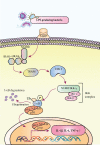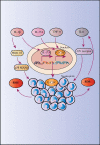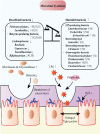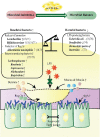Potential of Omega-3 Polyunsaturated Fatty Acids in Managing Chemotherapy- or Radiotherapy-Related Intestinal Microbial Dysbiosis
- PMID: 30566596
- PMCID: PMC6370266
- DOI: 10.1093/advances/nmy076
Potential of Omega-3 Polyunsaturated Fatty Acids in Managing Chemotherapy- or Radiotherapy-Related Intestinal Microbial Dysbiosis
Abstract
Chemotherapy- or radiotherapy-related intestinal microbial dysbiosis is one of the main causes of intestinal mucositis. Cases of bacterial translocation into peripheral blood and subsequent sepsis occur as a result of dysfunction in the intestinal barrier. Evidence from recent studies depicts the characteristics of chemotherapy- or radiotherapy-related intestinal microbial dysbiosis, which creates an imbalance between beneficial and harmful bacteria in the gut. Decreases in beneficial bacteria can lead to a weakening of the resistance of the gut to harmful bacteria, resulting in robust activation of proinflammatory signaling pathways. For example, lipopolysaccharide (LPS)-producing bacteria activate the nuclear transcription factor-κB signaling pathway through binding with Toll-like receptor 4 on stressed epithelial cells, subsequently leading to secretion of proinflammatory cytokines. Nevertheless, various studies have found that the omega-3 (n-3) polyunsaturated fatty acids (PUFAs) such as docosahexaenoic acid and eicosapentaenoic acid can reverse intestinal microbial dysbiosis by increasing beneficial bacteria species, including Lactobacillus, Bifidobacterium, and butyrate-producing bacteria, such as Roseburia and Coprococcus. In addition, the n-3 PUFAs decrease the proportions of LPS-producing and mucolytic bacteria in the gut, and they can reduce inflammation as well as oxidative stress. Importantly, the n-3 PUFAs also exert anticancer effects in colorectal cancers. In this review, we summarize the characteristics of chemotherapy- or radiotherapy-related intestinal microbial dysbiosis and introduce the contributions of dysbiosis to the pathogenesis of intestinal mucositis. Next, we discuss how n-3 PUFAs could alleviate chemotherapy- or radiotherapy-related intestinal microbial dysbiosis. This review provides new insights into the clinical administration of n-3 PUFAs for the management of chemotherapy- or radiotherapy-related intestinal microbial dysbiosis.
Figures





Similar articles
-
The protective role of short-chain fatty acids acting as signal molecules in chemotherapy- or radiation-induced intestinal inflammation.Am J Cancer Res. 2020 Nov 1;10(11):3508-3531. eCollection 2020. Am J Cancer Res. 2020. PMID: 33294252 Free PMC article. Review.
-
Microbiota, a New Playground for the Omega-3 Polyunsaturated Fatty Acids in Cardiovascular Diseases.Mar Drugs. 2021 Jan 23;19(2):54. doi: 10.3390/md19020054. Mar Drugs. 2021. PMID: 33498729 Free PMC article. Review.
-
Chemotherapy-Induced Intestinal Microbiota Dysbiosis Impairs Mucosal Homeostasis by Modulating Toll-like Receptor Signaling Pathways.Int J Mol Sci. 2021 Aug 31;22(17):9474. doi: 10.3390/ijms22179474. Int J Mol Sci. 2021. PMID: 34502383 Free PMC article. Review.
-
N-3 Polyunsaturated Fatty Acids and Gut Microbiota.Comb Chem High Throughput Screen. 2023;26(5):892-905. doi: 10.2174/1386207325666220701121025. Comb Chem High Throughput Screen. 2023. PMID: 35786331 Review.
-
A randomised trial of the effect of omega-3 polyunsaturated fatty acid supplements on the human intestinal microbiota.Gut. 2018 Nov;67(11):1974-1983. doi: 10.1136/gutjnl-2017-314968. Epub 2017 Sep 26. Gut. 2018. PMID: 28951525 Clinical Trial.
Cited by
-
The Lactobacillus brevis 47 f Strain Protects the Murine Intestine from Enteropathy Induced by 5-Fluorouracil.Microorganisms. 2020 Jun 9;8(6):876. doi: 10.3390/microorganisms8060876. Microorganisms. 2020. PMID: 32527057 Free PMC article.
-
Pre- to Postbiotics: The Beneficial Roles of Pediatric Dysbiosis Associated with Inflammatory Bowel Diseases.Microorganisms. 2024 Aug 2;12(8):1582. doi: 10.3390/microorganisms12081582. Microorganisms. 2024. PMID: 39203424 Free PMC article. Review.
-
Improvement in Glycolipid Metabolism Parameters After Supplementing Fish Oil-Derived Omega-3 Fatty Acids Is Associated with Gut Microbiota and Lipid Metabolites in Type 2 Diabetes Mellitus.Nutrients. 2024 Oct 31;16(21):3755. doi: 10.3390/nu16213755. Nutrients. 2024. PMID: 39519588 Free PMC article. Clinical Trial.
-
Microbiota and Resveratrol: How Are They Linked to Osteoporosis?Cells. 2024 Jul 3;13(13):1145. doi: 10.3390/cells13131145. Cells. 2024. PMID: 38994996 Free PMC article. Review.
-
Gut microbiota and radiation-induced injury: mechanistic insights and microbial therapies.Gut Microbes. 2025 Dec;17(1):2528429. doi: 10.1080/19490976.2025.2528429. Epub 2025 Jul 6. Gut Microbes. 2025. PMID: 40618373 Free PMC article. Review.
References
-
- Keefe DM, Schubert MM, Elting LS, Sonis ST, Epstein JB, Raber-Durlacher JE, Migliorati CA, McGuire DB, Hutchins RD, Peterson DE et al. . Updated clinical practice guidelines for the prevention and treatment of mucositis. Cancer 2007;109(5):820–31. - PubMed

